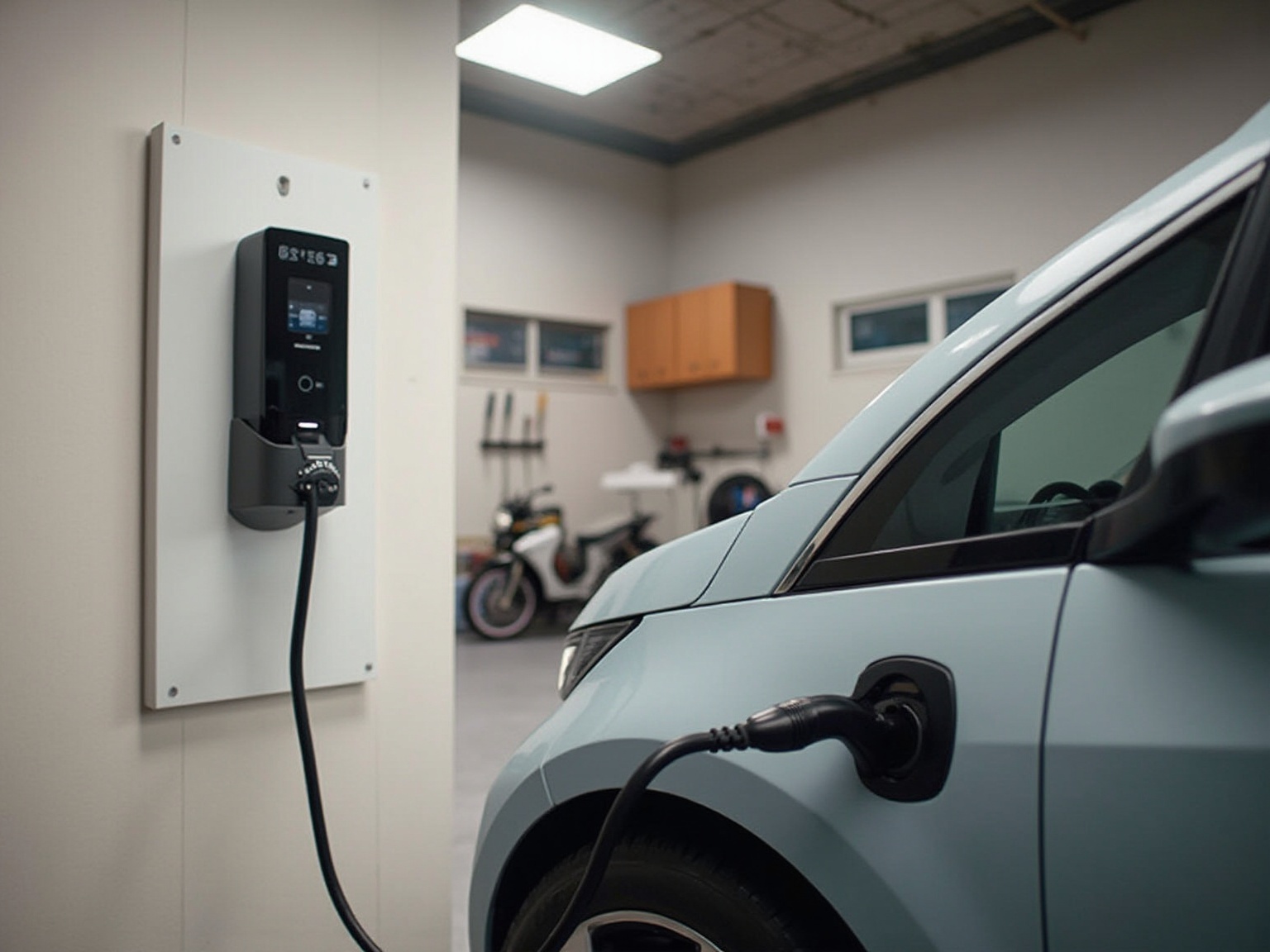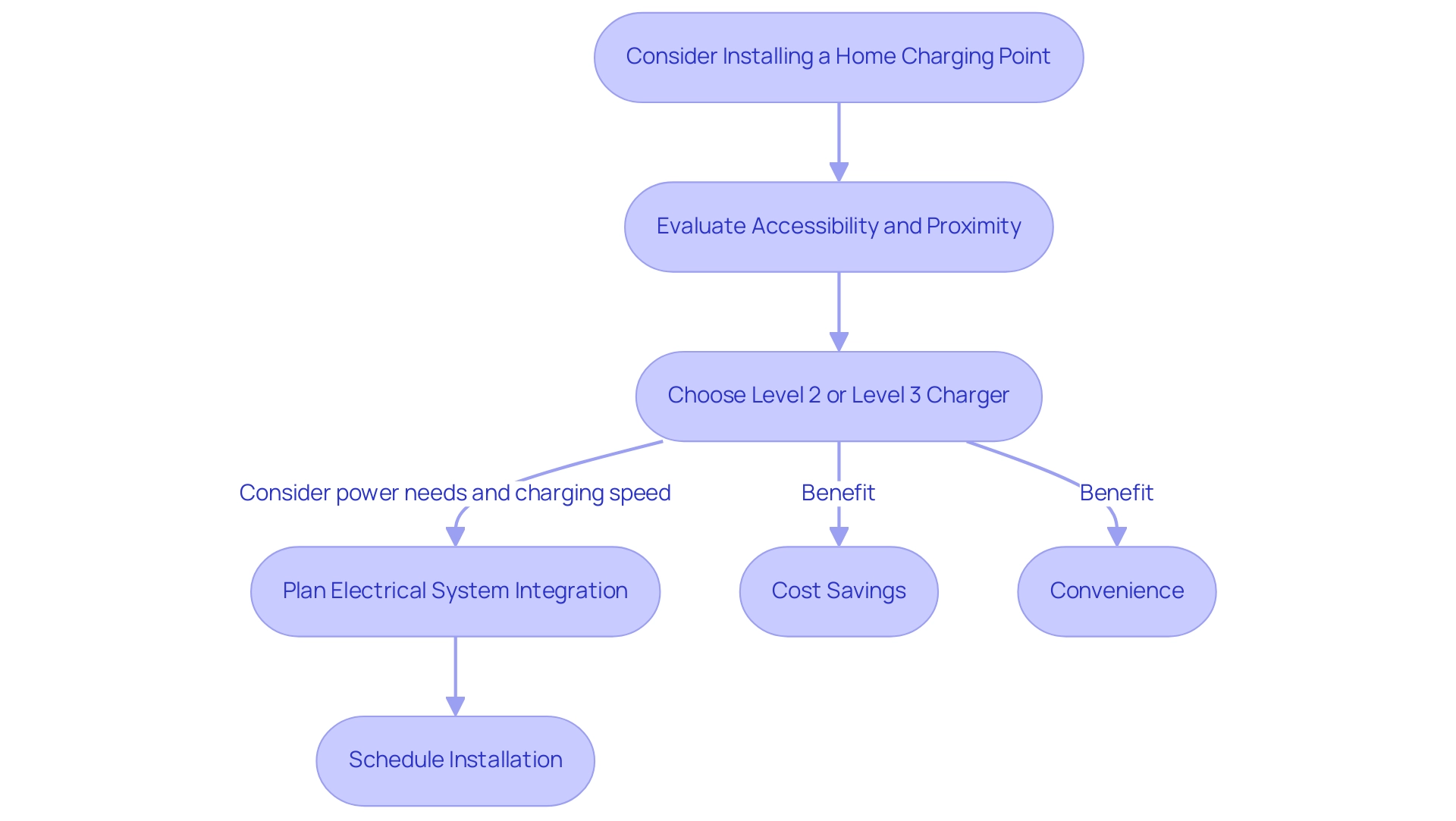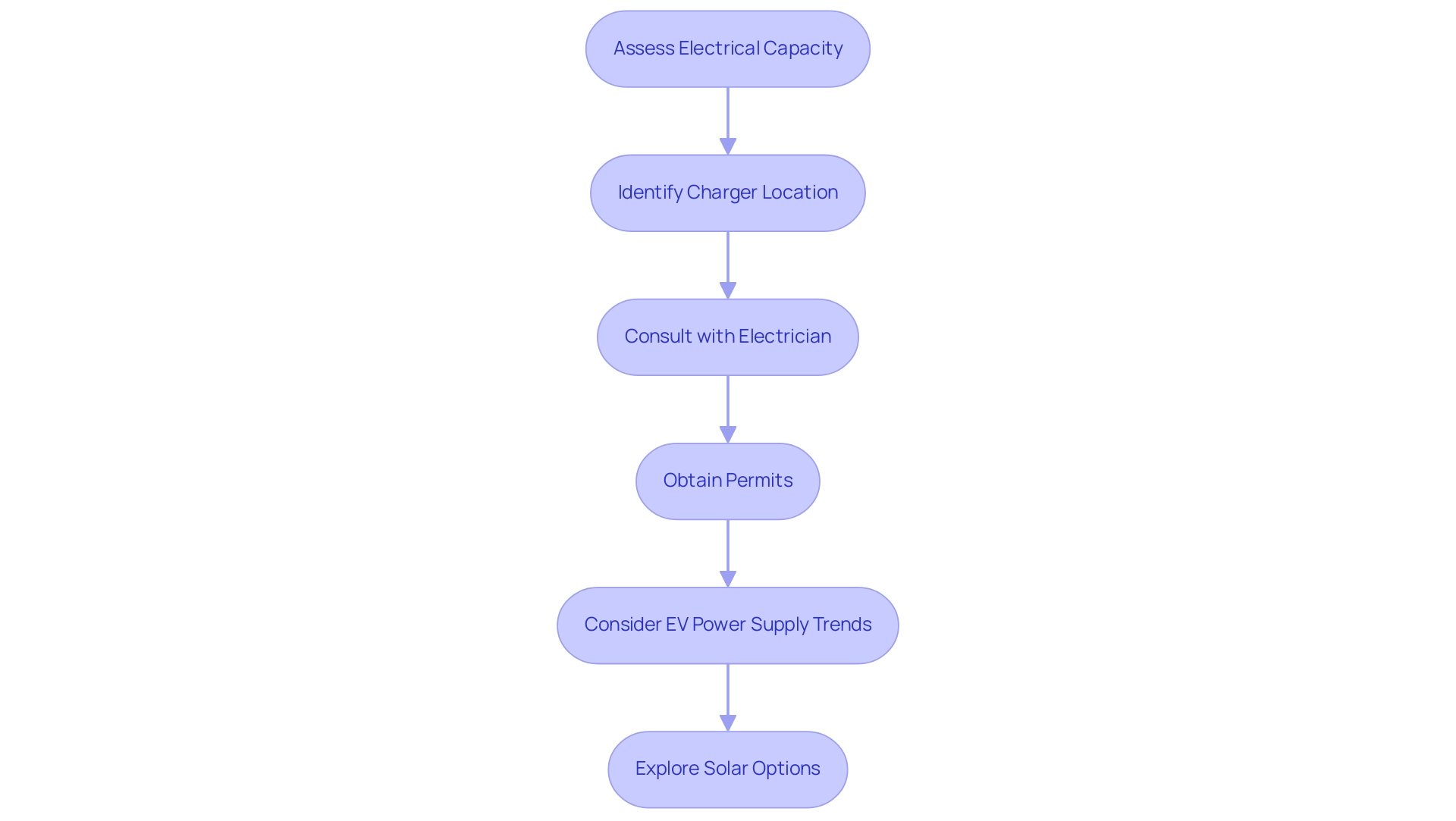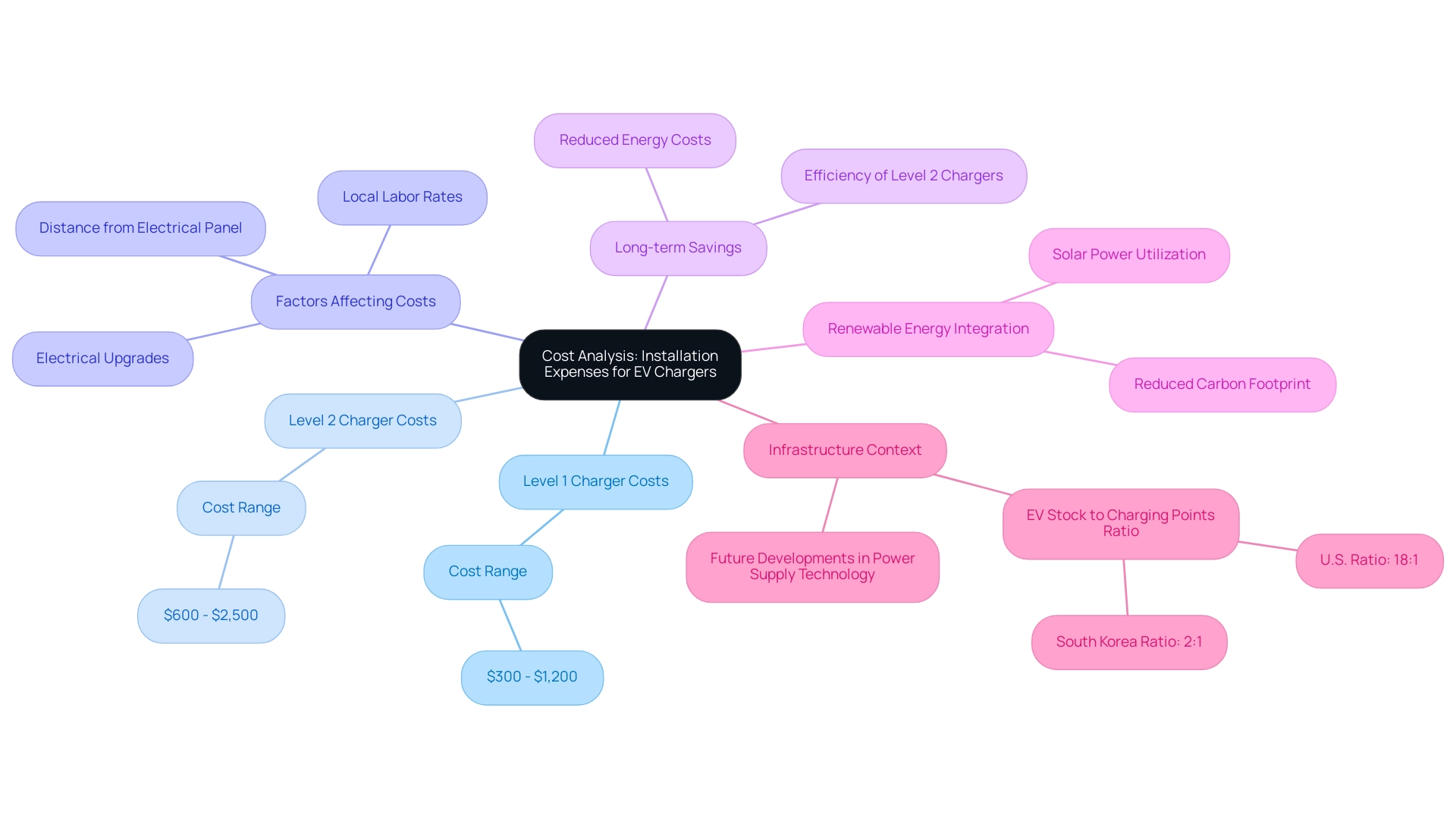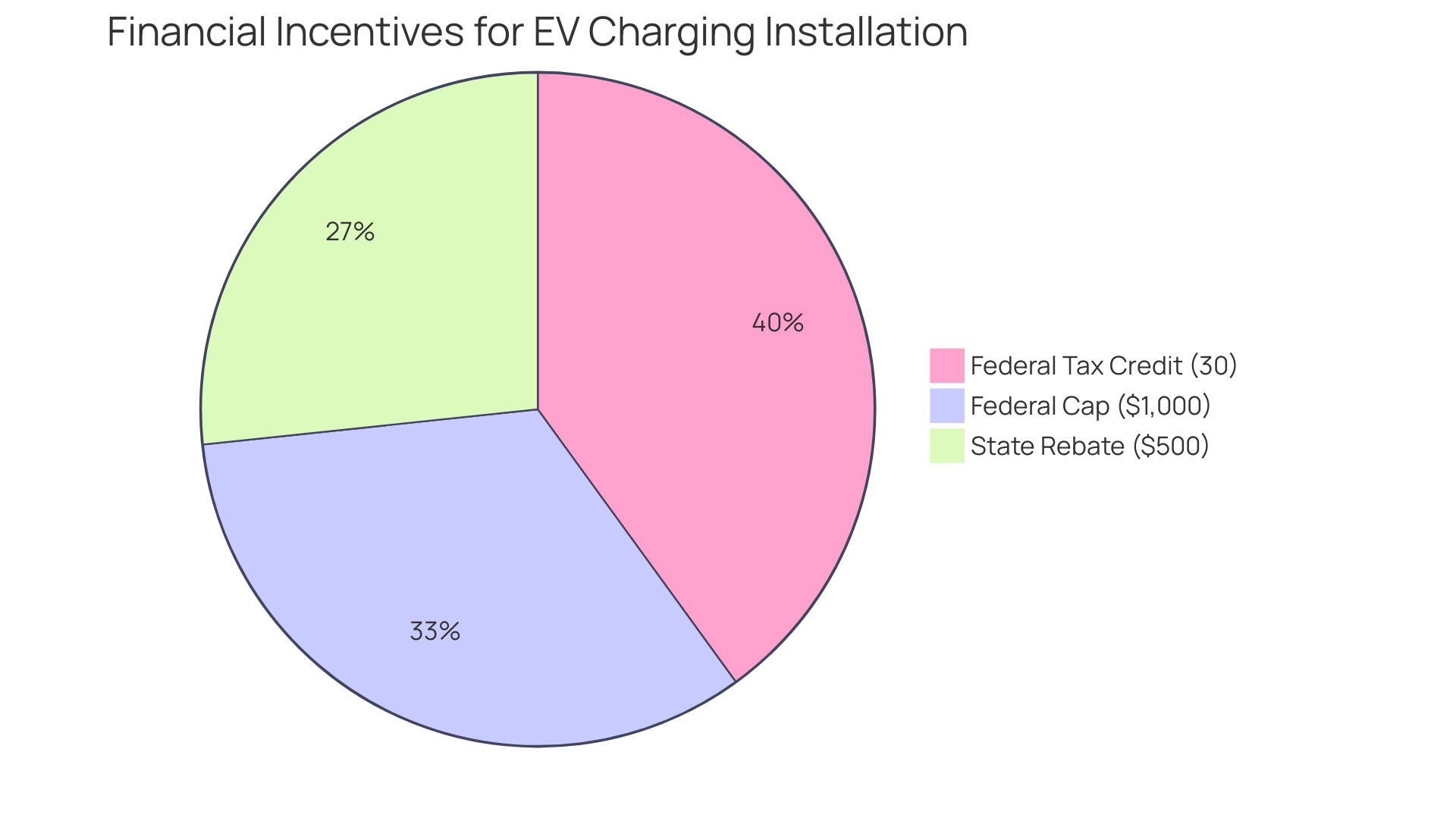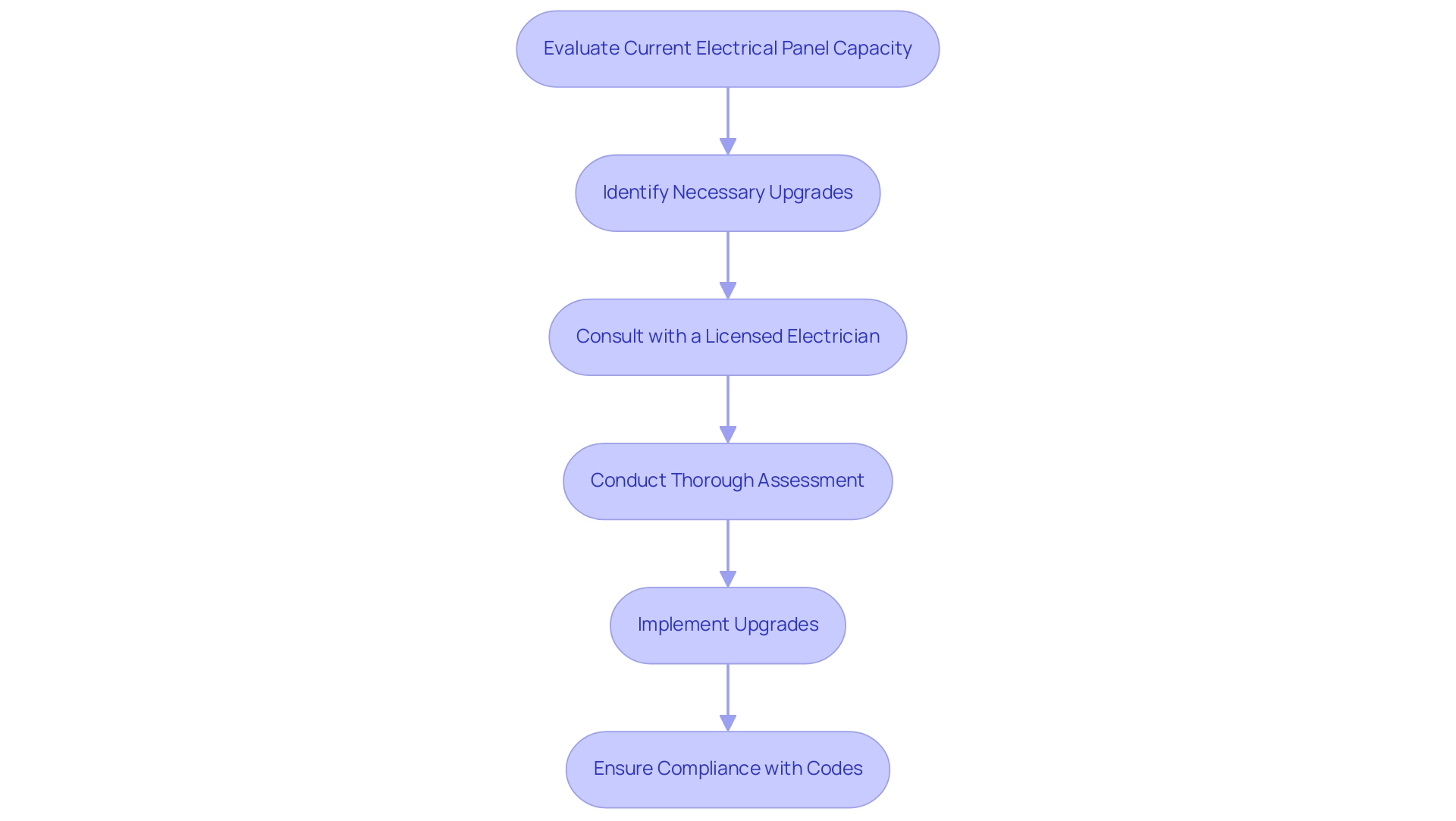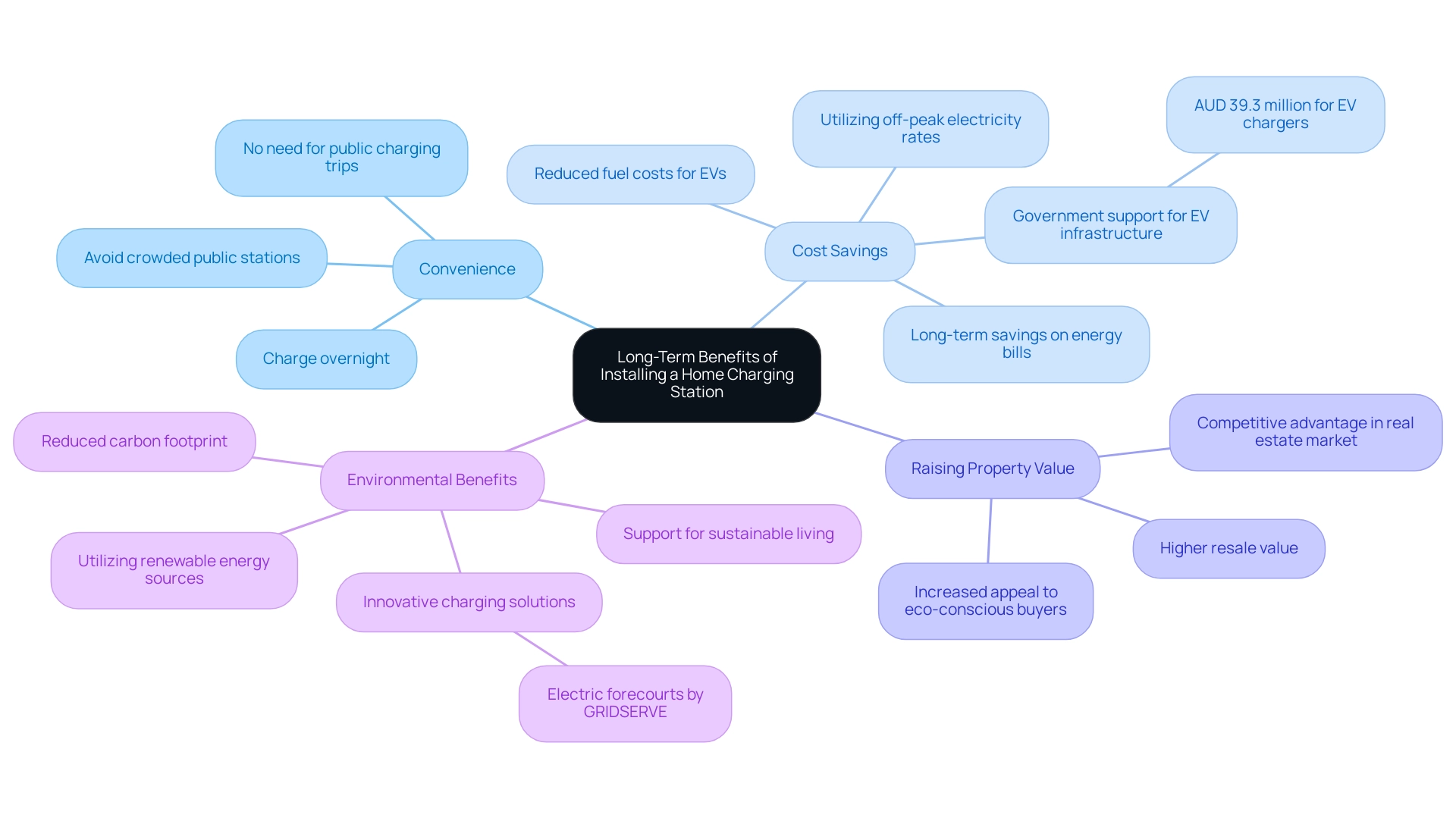Overview
We understand that many homeowners are concerned about rising energy bills and are seeking solutions that not only alleviate these worries but also contribute to a sustainable future. This article serves as a comprehensive checklist for installing a home charging point for electric cars, emphasizing the importance of preparation and informed decision-making. By detailing the types of chargers available, necessary electrical assessments, installation considerations, associated costs, and available incentives, we aim to provide you with the essential information needed for a successful and efficient installation process. Together, we can navigate this journey towards energy independence and make choices that benefit both your household and the environment.
Introduction
As we navigate the shift towards more sustainable transportation options, electric vehicles (EVs) are becoming a beacon of hope for many, projected to represent over half of new vehicle sales in the U.S. by 2030. We understand that the prospect of rising energy bills can be daunting, but central to this revolution is the convenience of home charging points, empowering EV owners to effortlessly recharge their vehicles right from the comfort of their garages.
With the increasing demand for efficient and reliable charging solutions, it’s essential for homeowners to grasp the various types of chargers, installation requirements, and associated costs. This article delves into the intricacies of home charging stations, offering insights into the benefits of Level 1 and Level 2 chargers, installation considerations, and the long-term advantages of embracing this eco-friendly technology.
As the electric vehicle landscape evolves, it opens up wonderful opportunities for homeowners to enhance their energy efficiency and invest in a sustainable future together.
Understanding Home Charging Points for Electric Vehicles
- Residential recharging stations, often referred to as home charging points for electric cars, are essential setups that empower electric vehicle (EV) owners to conveniently charge their vehicles at home. These stations are vital in enhancing the EV ownership experience by providing a reliable and accessible charging option. As the electric vehicle market continues to expand, with predictions indicating that EVs will account for over 50% of new vehicle sales in the U.S. by 2030, establishing a home charging point has never been more important. As the President of Qmerit Network expressed, “We’re here to make your electrification journey easy and provide a first-class experience with the highest quality of materials and service.” Powercore Electric is dedicated to supporting this transition with expert installation services and energy-saving solutions that help alleviate the burden of rising energy costs. Our residential power solutions include Level 2 and Level 3 devices, designed to meet diverse power needs and significantly reduce charging time compared to standard household outlets.
- Home charging points for electric cars operate by connecting to a residence’s electrical system, typically requiring a dedicated circuit to ensure safe and efficient power transfer. Most residential chargers utilize Level 2 power supply, which operates at 240 volts, greatly reducing charging time compared to standard outlets. This setup not only allows for quicker recharging but also integrates seamlessly with the home’s electricity system, enabling scheduled charging during off-peak hours to enhance cost efficiency. By leveraging Powercore Electric’s solar solutions, homeowners can further boost their energy efficiency and lower their overall electricity bills. Our installation process is straightforward, ensuring that your charging point is set up efficiently and safely, tailored to the specific electrical configuration of your home.
- The benefits of having a residential power station are substantial. Primarily, they offer unparalleled convenience, allowing EV owners to charge their vehicles overnight without the hassle of visiting public charging stations. This not only saves time but also reduces costs, as residential electricity rates are generally lower than public charging fees. Furthermore, with the Infrastructure Investment and Jobs Act allocating $7.5 billion for electric vehicle charging infrastructure, the environment for establishing a home charging point is becoming increasingly favorable, making it a wise investment for homeowners. Powercore Electric, as a locally owned and community-focused entity, ensures that clients receive personalized service and support throughout the installation process, making the transition to residential power supply smooth and effective. We invite homeowners to reach out to us for a consultation to explore the best power solutions tailored to their needs.
- Selecting the right location for a home charging point installation is crucial. Considerations such as accessibility, proximity to the parking area, and the layout of the home’s electrical system should be thoughtfully evaluated. A well-placed power outlet can enhance the user experience, ensuring that the vehicle is easily accessible for charging while minimizing the need for long extension cords or complex wiring. Real-life examples of successful installations illustrate that careful planning can lead to greater satisfaction and ease of use for EV owners, reinforcing the value of Powercore Electric’s expertise in this area.
Types of EV Chargers: Level 1 vs. Level 2
When considering a home charging point for electric car solutions, we understand that making an informed decision is crucial. It’s essential to grasp the differences between Level 1 and Level 2 chargers. Powercore Electric is here to provide professional setup services for both categories of chargers, ensuring that you can select the optimal home charging point to meet your electric car needs.
Level 1 Chargers operate at a voltage of 120V and typically deliver a power rate of 2 to 5 miles of range per hour. This makes them suitable for homeowners who may not drive extensively on a daily basis or have the luxury of overnight power replenishment. The setup expenses for Level 1 chargers are generally lower, as they can often be plugged into standard household outlets without requiring extensive electrical work. We at Powercore Electric can assist with the setup process, ensuring safety and compliance with local regulations.
Level 2 Chargers, on the other hand, function at a voltage of 240V and can provide speeds of up to 25 miles of range per hour. This makes them ideal for individuals with longer commutes or those who frequently use their electric vehicles throughout the day. While the installation costs for Level 2 chargers may be higher due to the need for specialized electrical work, the benefits in terms of speed and convenience often outweigh these initial expenses. Powercore Electric specializes in the installation of Level 2 chargers, offering you a reliable and efficient charging solution.
Pros and Cons:
- Level 1 Chargers:
- Pros: Lower installation costs, easy setup, sufficient for light users.
- Cons: Slow charging speed, may not meet the needs of daily commuters.
- Level 2 Chargers:
- Pros: Faster charging, suitable for frequent use, enhances convenience for daily drivers.
- Cons: Higher installation costs, requires professional installation.
Real-World Scenarios:
- If you primarily use your vehicle for short trips and have access to overnight charging, a Level 1 charger may be sufficient. This option allows for a cost-effective solution without the need for significant electrical upgrades, and Powercore Electric can provide the necessary installation support. Conversely, for a family with multiple electric vehicles or a daily commuter who travels long distances, a Level 2 charger would be more beneficial.
The ability to quickly recharge your vehicle during the day can significantly enhance your overall driving experience and alleviate range anxiety. Powercore Electric’s expertise in installing Level 2 chargers ensures that families can maximize their energy replenishment efficiency.
Given the recent $25 million investment announced in January 2024 for expanding EV infrastructure, it’s clear that interest in these solutions is growing. Substantial global investments in EV refueling infrastructure are being driven by government initiatives and consumer interest in sustainable travel. As Tajammul Pangarkar, CMO at Prudour Pvt Ltd, observes, the advancement of EV refueling technology is vital for facilitating this transition.
Moreover, with worldwide lithium-ion automotive battery production capacity anticipated to reach 3.2 TWh by 2030, the importance of home refueling solutions will only increase as more electric vehicles take to the streets. Understanding the categories of electric transport refueling stations, such as Level 1 and Level 2 chargers, is crucial for those involved in planning and implementing EV refueling infrastructure.
In conclusion, the decision between Level 1 and Level 2 chargers for your home charging point should be guided by your personal driving patterns, financial considerations, and the specific energy requirements of your household. By understanding these differences, you can empower yourself to select the most appropriate charging solution for your electric vehicles. For more information on installation services, please feel free to contact Powercore Electric at (916) 699-8778 or via email at ryan.serrano@powercoreinc.net.
Additionally, Powercore Electric offers a variety of services, including solar panels and battery backups, to further enhance energy efficiency in your home.
Preparing for Installation: Key Considerations and Steps
- Assessing your residence’s electrical capacity is a crucial first step before installing a home charging point for your electric car. Understanding your electrical system involves checking the amperage of your electrical panel to ensure it can handle the additional load of the charger. Many homes may need upgrades to accommodate this increased demand, particularly if you plan to install a Level 2 charger requiring a 240-volt outlet. By 2025, it is estimated that around 60% of residences will need some form of electrical upgrade to support EV charging, underscoring the importance of this assessment. At Powercore Electric, we are here to assist you in this evaluation, ensuring your home is prepared for the transition to electric vehicle ownership through a reliable home charging point.
- Identifying the Best Location for Your Home Charging Point: The placement of your home charging point is essential for both convenience and safety. Ideally, the charger should be situated near your parking area, allowing easy access while also being protected from the elements. It’s also wise to consider the proximity to your electrical panel to help reduce costs. A well-placed charging point can enhance your experience and encourage regular use, reflecting Powercore Electric’s commitment to providing efficient and user-friendly solutions.
- Consulting with a licensed electrician is vital to evaluate your electrical system and discuss setup options for your home charging point. They can offer insights into necessary upgrades and help you navigate local regulations or codes. Their expertise guarantees that your setup is safe, compliant, and tailored to your specific needs. As we approach 2025, expert opinions emphasize the importance of professional evaluations, as improper setups can lead to safety risks and inefficiencies. As Tajammul Pangarkar, CMO at Prudour Pvt Ltd, notes, ‘Appropriate setup is crucial in the evolving landscape of EV technology, ensuring both safety and efficiency.’ The team at Powercore Electric is dedicated to making your home charging point installation seamless and effective.
- Obtaining Necessary Permits or Approvals: Before beginning your setup, it’s important to check with local authorities to see if any permits or approvals are needed. This step is essential for ensuring compliance with local building codes and regulations. Many jurisdictions have specific requirements for home charging point installations, and securing the necessary permits can prevent delays and complications. As the EV market continues to grow, local governments are increasingly simplifying these processes to encourage the adoption of electric transportation. Additionally, with global lithium-ion automotive battery production capacity expected to reach 3.2 TWh by 2030, the demand for residential power solutions will only increase, highlighting the need to stay informed about local regulations. Powercore Electric is here to guide you through this process, ensuring that all necessary steps are taken.
- Considering Trends in EV Power Supply: The increase in publicly accessible stations across Europe, which rose by 30% in 2021, illustrates the growing adoption of electric vehicles and the need for home power solutions. Understanding these trends can empower homeowners to make informed decisions about their home charging point installations. Powercore Electric is committed to staying ahead of these trends by offering innovative solutions, such as home charging points, that support a sustainable future.
- Exploring Solar Panel and Battery Options: As you contemplate your home charging point installation, it’s also beneficial to explore how solar panels can complement your charging system. Solar panels can provide a renewable energy source, reducing reliance on the grid and lowering energy costs. Additionally, choosing the right solar battery can enhance your energy storage capabilities, allowing you to store excess energy generated during the day for nighttime use or during peak demand periods. Powercore Electric offers guidance on the best solar solutions tailored to your needs, which can include setting up a home charging point for your electric car.
Are you ready to make the switch to electric cars? Together, we can embrace a cleaner, more sustainable future. Contact Powercore Electric today to learn more about our EV charging solutions and how we can support you on this journey.
Cost Analysis: Understanding Installation Expenses
When considering the installation of a home charging point for your electric car, we understand that grasping the typical costs associated with Level 1 and Level 2 chargers is essential. As we look ahead to 2025, the average setup costs for a Level 1 charger range from $300 to $1,200, while Level 2 chargers typically cost between $600 and $2,500. These figures encompass both equipment and labor expenses, with labor often accounting for a significant portion of the total cost.
Several factors can affect these setup costs. For instance, if your home requires electrical upgrades to accommodate the charger, this can add to the overall expense. The distance from the electrical panel to the setup site also plays a crucial role; longer distances may necessitate additional wiring and labor, further increasing costs. We recognize that local labor rates can fluctuate significantly, impacting the final cost of setup.
To ensure you receive the best value, it’s advisable to obtain multiple quotes from licensed electricians. When comparing costs, consider not only the setup price but also the quality of the equipment and the electrician’s experience. Asking for detailed breakdowns of the quotes can help you make informed decisions.
While upfront installation costs are important, it’s equally vital to consider the long-term savings on energy bills. Investing in a Level 2 charger, like those provided by Powercore Electric, can significantly decrease the time required to replenish your EV compared to a Level 1 charger, which can take up to three days to fully recharge. This efficiency can lead to lower electricity costs over time, making the initial investment more worthwhile.
Moreover, integrating your EV power solution with renewable energy sources, such as solar power, can further enhance efficiency and sustainability. By utilizing solar energy to power your chargers, you can benefit from reduced energy costs and a smaller carbon footprint. This holistic approach not only addresses immediate power requirements but also aligns with eco-conscious living.
It’s important to recognize the context of power supply infrastructure availability. In 2020, the ratio of electric transport stock to public power sources in the U.S. was 18:1, indicating a significant gap in infrastructure for recharging. This disparity may impact your choices regarding EV charger setups, as having a dependable home power solution becomes increasingly essential.
As Tajammul Pangarkar, CMO at Prudour Pvt Ltd, observes, “The progress of power supply technology is essential for the acceptance of electric transports, and homeowners should take future developments into account when investing in power solutions.” Moreover, progress in automotive technology is anticipated to allow greater power replenishment rates, making it beneficial for homeowners to prepare their setups for the future.
In summary, understanding the costs and factors affecting the setup of a home charging point for your electric car can empower you to make informed choices. By assessing setup costs against possible long-term savings and taking into account the wider context of power infrastructure and renewable energy integration, together we can select the optimal power solution for your electric transport, especially with the innovative offerings from Powercore Electric.
Exploring Incentives and Rebates for EV Charging Installation
Homeowners often find themselves grappling with rising energy bills, and we understand how overwhelming that can feel. Fortunately, there are various federal and state incentives designed to alleviate these concerns and promote the adoption of electric vehicles (EVs) along with the installation of home charging points. The federal government offers a generous tax credit of up to 30% of the cost of purchasing and installing a home charging point for electric cars, capped at $1,000 for residential setups. Additionally, many states, like Wyoming, provide their own rebates—currently, a $500 rebate is available for residential customers who install a home charging point for electric cars. This makes the transition to electric vehicles not only more feasible but also more affordable for homeowners.
These incentives are particularly vital in 2025, as the EV and Electric Vehicle Supply Equipment (EVSE) sector faces challenges that necessitate financial support for promoting home charging points. At Powercore Electric, we are here to support you. With over 30 years of experience serving the California community, we take pride in delivering high-quality services and maintenance through our dedicated in-house team of specialists.
As one satisfied customer shared, “Ryan and his team were great. They were fast, efficient, and stayed on schedule for our solar installation.” Another customer noted, “I have referred Powercore to some friends, and they were also happy with their service.” This feedback underscores our commitment to exceptional service and local expertise. Together, we can make sustainable energy solutions accessible, ensuring that you feel confident and supported every step of the way. Let’s work towards a greener future, where energy independence is within your reach.
Assessing Your Home’s Electrical Infrastructure for EV Charging
Begin by evaluating your current electrical panel capacity to determine if it can handle the additional load from a home charging point for your electric car. As we move towards 2025, many residences may require a panel that supports at least 200 amps to accommodate the demands of a home charging point for electric car charging alongside other household needs.
It’s essential to identify necessary upgrades, which may include:
- Increasing the amperage of your panel
- Adding dedicated circuits specifically for the home charging point for your electric car
This ensures that your residence can efficiently manage the power requirements needed for a home charging point without overloading the system. We understand that navigating these upgrades can feel overwhelming, so consulting with a licensed electrician is crucial. They can conduct a thorough assessment of your home’s wiring and electrical systems to ensure they are suitable for a home charging point for your electric car. Their expertise is invaluable in identifying potential issues and ensuring that your infrastructure is robust enough to support electric vehicle use.
At Powercore Electric, we specialize in this process, providing a thorough site assessment to identify the optimal place for your power station and any electrical requirements. It’s important to ensure that the home charging point setups comply with local electrical codes and safety regulations. This not only guarantees safety but also aligns with the growing trend of sustainable energy practices, as seen in initiatives like Sweden’s commitment to electrifying highways by 2025. This reflects a broader movement towards innovative power solutions that support the increasing adoption of electric vehicles.
Consider real-world examples of electrical upgrades for installing a home charging point for your electric car. For instance, homeowners in California have successfully transitioned to EV refueling by upgrading their panels and wiring to support a home charging point, demonstrating the feasibility and benefits of such enhancements.
Evaluate your residence’s electrical system to ensure it can support a home charging point by considering aspects like the age of your electrical panel and the state of your wiring. Expert opinions suggest that older systems may require significant upgrades to meet modern energy demands, particularly as the adoption of electric vehicles rises and the need for a home charging point becomes more prevalent.
Addressing potential ‘range anxiety’ concerns is crucial, as a dependable home charging point can alleviate worries about EV usage. Stay informed about necessary upgrades for residential electrical systems to support a home charging point. Statistics suggest that as EV adoption increases, so does the necessity for residences to have a home charging point, modifying their electrical systems accordingly to accommodate the rising number of electric transports on the road.
Together, we can ensure your home is ready for this transition. For further details about our offerings, including solar panels, battery backups, and EV power stations, please reach out to Powercore Electric at ryan.serrano@powercoreinc.net or call (916) 699-8778.
Long-Term Benefits of Installing a Home Charging Station
-
We understand that the convenience of a home charging point for your electric car can bring unmatched ease in refueling compared to public power stations. Imagine connecting your vehicle overnight, ensuring it’s fully powered by morning without the hassle of special trips to a power station. In contrast, public power stations can often feel crowded, leading to wait times and potential delays in your busy schedule. With the rise of home charging points for electric cars, many homeowners are discovering that the comfort of refueling at home significantly enhances their overall EV ownership experience. As Omar Vargas, head of public policy at General Motors, highlights, “We’re looking at what are the best locations to install an EV refueling station for a community,” underscoring the importance of strategic placement in enhancing convenience.
-
Potential Cost Savings Over Time: It’s common to feel concerned about energy bills, but home refueling can lead to substantial cost savings in the long run. By utilizing off-peak electricity rates, homeowners can power their EVs at a lower cost compared to public stations, which often impose premium rates during peak hours. Moreover, research shows that property owners can save thousands of dollars throughout the lifespan of their automobile by utilizing a home charging point for electric cars instead of depending on public facilities. This financial advantage is further amplified when considering the reduced fuel costs associated with electric vehicles. The Australian Government’s recent declaration of AUD 39.3 million to construct EV stations along national highways highlights the increasing support for EV infrastructure, enhancing the benefits of residential power solutions.
-
Raising Property Value: You may be wondering how to enhance your property’s worth. Installing a residential electric vehicle station can not only boost your property’s value but also attract future purchasers. As the demand for electric vehicles continues to rise, residences with a home charging point for electric cars are becoming increasingly appealing in the real estate market. This feature not only meets the needs of eco-conscious buyers but also positions your property favorably in a competitive market, potentially leading to a higher resale value. The availability of reliable setup services, like those offered by Powercore Electric, which focuses on solar panels and provides a home charging point for electric cars along with EV power stations, enhances the trustworthiness of residential energy solutions.
-
Environmental Benefits: It’s heartening to know that utilizing renewable energy sources for home power, particularly when combined with solar installations from Powercore Electric, significantly enhances the environmental advantages of owning an electric automobile. By harnessing solar energy to power your EV, you reduce your carbon footprint and contribute to a more sustainable future. This synergy between solar energy and electric vehicle power supply not only promotes energy independence but also aligns with the growing trend towards eco-friendly living, making it a responsible choice for homeowners committed to sustainability. The emergence of innovative market entrants like GRIDSERVE, which are creating electric forecourts, showcases the evolving landscape of EV charging solutions and the potential for enhanced charging experiences.
Conclusion
Home charging points are not just a convenience; they are a vital part of the electric vehicle (EV) ecosystem, offering reliability and peace of mind for EV owners. As more people turn to electric vehicles, it’s natural to have questions about the differences between Level 1 and Level 2 chargers, as well as their unique benefits and installation needs. With various federal and state incentives available, investing in a home charging solution is a step that brings immediate convenience, long-term financial savings, and even an increase in property value.
We understand that preparing for installation can feel overwhelming. It starts with a careful assessment of your home’s electrical infrastructure to ensure it can handle the additional load of an EV charger. By consulting with licensed electricians and securing the necessary permits, you can simplify the installation process, making it efficient and compliant with local regulations. Additionally, integrating solar panels with your EV charging system can significantly boost energy efficiency, lower costs, and support a sustainable lifestyle.
Ultimately, embracing home charging solutions empowers you to take charge of your energy consumption while making a positive impact on the environment. As the electric vehicle landscape evolves, there’s no better time than now to invest in a home charging station that meets your personal needs and aligns with the growing movement towards sustainable transportation. Together, we can navigate this transition, and Powercore Electric is here to assist you every step of the way, offering expert installation services to help you fully enjoy the benefits of electric vehicle ownership.


